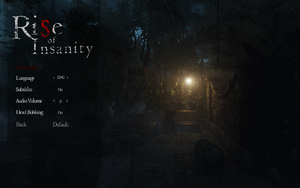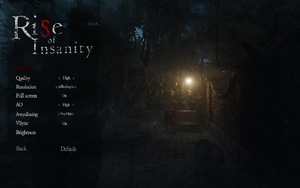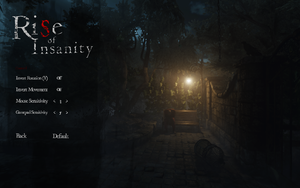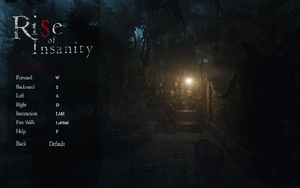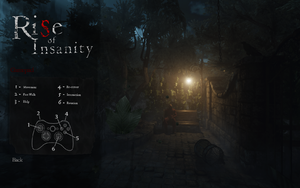Rise of Insanity
From PCGamingWiki, the wiki about fixing PC games
 |
|
| Developers | |
|---|---|
| Red Limb Studio | |
| Engines | |
| Unity 5[Note 1] | |
| Release dates | |
| Windows | March 1, 2018 |
| Linux | March 1, 2018 |
| Reception | |
| Metacritic | 62 |
| OpenCritic | 53 |
| Taxonomy | |
| Microtransactions | None |
| Modes | Singleplayer |
| Perspectives | First-person |
| Controls | Direct control |
| Genres | Adventure |
| Art styles | Realistic |
| Themes | Contemporary, Horror |
Key points
- Hearing-impaired players may be unable to solve one puzzle.[2]
General information
Availability
| Source | DRM | Notes | Keys | OS |
|---|---|---|---|---|
| Steam |
Game data
Configuration file(s) location
| System | Location |
|---|---|
| Windows | %USERPROFILE%\AppData\LocalLow\Red Limb Studio\Rise of Insanity\playerInfo.dat HKEY_CURRENT_USER\Software\Red Limb Studio\Rise of Insanity |
| Linux | $XDG_CONFIG_HOME/unity3d/Red Limb Studio/Rise of Insanity/playerInfo.dat $XDG_CONFIG_HOME/unity3d/Red Limb Studio/Rise of Insanity/prefs |
- This game follows the XDG Base Directory Specification on Linux.
Save game data location
| System | Location |
|---|---|
| Windows | %USERPROFILE%\AppData\LocalLow\Red Limb Studio\Rise of Insanity\playerInfo.dat |
| Linux | $XDG_CONFIG_HOME/unity3d/Red Limb Studio/Rise of Insanity/playerInfo.dat |
Save game cloud syncing
| System | Native | Notes |
|---|---|---|
| Steam Cloud |
Video
| Graphics feature | State | Notes | |
|---|---|---|---|
| Widescreen resolution | |||
| Multi-monitor | |||
| Ultra-widescreen | Hor+ | ||
| 4K Ultra HD | |||
| Field of view (FOV) | |||
| Windowed | |||
| Borderless fullscreen windowed | Default fullscreen is borderless. Use windowed mode with -popupwindow parameter for alternative mode or -window-mode exclusive for exclusive fullscreen. |
||
| Anisotropic filtering (AF) | See the glossary page for potential workarounds. | ||
| Anti-aliasing (AA) | Off, Low, Medium, High, and Very High. | ||
| Vertical sync (Vsync) | |||
| 60 FPS and 120+ FPS | |||
| High dynamic range display (HDR) | See the glossary page for potential alternatives. | ||
- The game engine may allow for manual configuration of the game via its variables. See the Unity page for more details.
Input
| Keyboard and mouse | State | Notes |
|---|---|---|
| Remapping | ||
| Mouse acceleration | ||
| Mouse sensitivity | ||
| Mouse input in menus | ||
| Mouse Y-axis inversion | ||
| Controller | ||
| Controller support | ||
| Full controller support | ||
| Controller remapping | See the glossary page for potential workarounds. | |
| Controller sensitivity | ||
| Controller Y-axis inversion |
| Controller types |
|---|
| XInput-compatible controllers | ||
|---|---|---|
| Xbox button prompts | ||
| Impulse Trigger vibration |
| PlayStation controllers | Recognized, but with wrong control layout. |
|---|
| Tracked motion controllers | No motion tracking, only button inputs. | |
|---|---|---|
| Button/gesture prompts |
| Generic/other controllers |
|---|
| Additional information | ||
|---|---|---|
| Controller hotplugging | ||
| Haptic feedback | ||
| Digital movement supported | ||
| Simultaneous controller+KB/M |
Audio
| Audio feature | State | Notes |
|---|---|---|
| Separate volume controls | ||
| Surround sound | ||
| Subtitles | ||
| Closed captions | ||
| Mute on focus lost | ||
| Royalty free audio |
Localizations
| Language | UI | Audio | Sub | Notes |
|---|---|---|---|---|
| English | ||||
| Simplified Chinese | ||||
| German | ||||
| Italian | ||||
| Korean | ||||
| Polish | ||||
| Brazilian Portuguese | ||||
| Russian | ||||
| Spanish |
VR support
| Headsets | State | Notes | |
|---|---|---|---|
| SteamVR | |||
| Oculus VR (LibOVR) | |||
| Windows Mixed Reality | [3] | ||
| OSVR | |||
| Devices | |||
|---|---|---|---|
| Tracked motion controllers | No motion tracking, only button inputs. See Input for details. |
||
| Traditional controller | See Input for details. | ||
| Keyboard/Mouse | |||
| Play area | |||
|---|---|---|---|
| Seated | |||
| Standing | |||
| Room-scale | |||
Other information
API
| Technical specs | Supported | Notes |
|---|---|---|
| Direct3D | 9, 11 | |
| OpenGL | Linux only. |
| Executable | 32-bit | 64-bit | Notes |
|---|---|---|---|
| Windows | |||
| Linux |
System requirements
| Windows | ||
|---|---|---|
| Minimum | ||
| Operating system (OS) | 7 | |
| Processor (CPU) | PC: Intel Core 2 Quad Q6600 VR: Intel Core i5 4590 |
|
| System memory (RAM) | 4 GB | |
| Hard disk drive (HDD) | 10 GB | |
| Video card (GPU) | PC: Nvidia GeForce GTX 560 Ti VR: Nvidia GeForce GTX 970 |
|
- A 64-bit operating system is required.
| Linux | ||
|---|---|---|
| Minimum | ||
| Operating system (OS) | Ubuntu 16.04 | |
| Processor (CPU) | Intel Core 2 Quad Q6600 | |
| System memory (RAM) | 4 GB | |
| Hard disk drive (HDD) | 10 GB | |
| Video card (GPU) | Nvidia GeForce GTX 660 Ti 2 GB of VRAM |
|
- A 64-bit operating system is required.
Notes
References
- ↑ Verified by User:Waschbär on 2019-05-11
- ↑ Rise of Insanity Steam Community Discussions - information and solution - last accessed on 2021-02-23
- ↑ Rise of Insanity VR on Windows Mixed Reality - YouTube - last accessed on 2019-05-11

